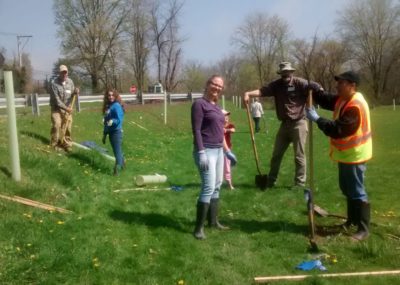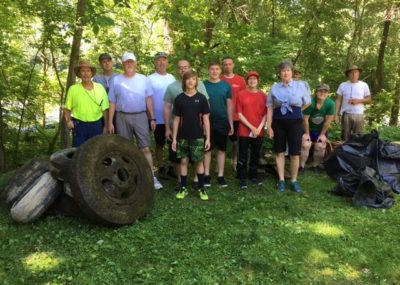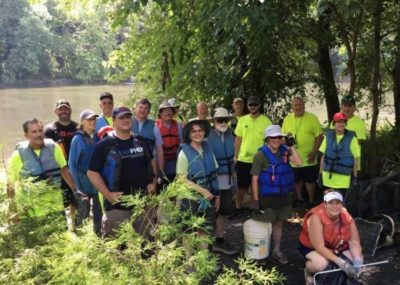Conodoguinet Creek flows 104.5 miles (168.1km) from high on the Kittatinny Ridge, down through the fertile Cumberland Valley, and into the Susquehanna River near Harrisburg. The name of the creek is borrowed from Native American words and means “A Long Way with Many Bends.” This stunning natural resource is a regional attraction that offers residents and visitors meaningful economic, recreational, and environmental value.
The lower 40 miles of the creek comprise the Conodoguinet Creek Water Trail, which is a recreational trail meandering through agricultural lands, and small towns. This section is an important part of the Pennsylvania Water Trails Partnerships program.
The Conodoguinet Creek Watershed Association (CCWA) is a non-profit, environmentally concerned citizens group created to take appropriate action on matters that affect the welfare of the Conodoguinet Creek Watershed.
You can explore the Conodoguinet Creek and Watershed by watching videos, reading text, following links, and interacting with the geology and water trail maps. The story map is designed to feature topics regarding the Conodoguinet Creek Watershed such as the importance of watershed education, conservation, geology, agriculture, riparian buffers, and recreation. The spirit of multi-generational volunteerism among community and partner organizations is a theme throughout the story map.
This story map illustrates how community and volunteerism connect education and conservation principles to enhance the health of the Conodoguinet Creek Watershed. The health of our local watershed affects the water quality of the Conodoguinet Creek that flows downstream into the Susquehanna River, to the Chesapeake Bay, and ultimately our global oceans.
CCWA hopes that the story map experience inspires you to explore the Conodoguinet Creek though recreation, connect with people, and act by volunteering with CCWA and with our many partners as stewards of our shared environment. Conodoguinet Creek Watershed Association appreciates the grant funding from the Pennsylvania Environmental Council and creation of the story map by Shippensburg University – Center for Land Use & Sustainability.

Every 3rd Saturday (8:45 am - Noon) May - September.
Cleanups are very dependent upon weather conditions and stream height.
Creek Clean-up registration is TBA

Volunteer to help us plant trees! Partners are Camp Hill Borough and Chesapeake Bay Foundation the Keystone 10 Million Tree Partnership.
Tree planting registration is TBA

Watershed Monitoring in Partnership with ALLARM to conduct MONTHLY water testing. Members will meet on site and use field kits for water quality monitoring data.
Email allarm@dickinson.edu or (717) 243-5121

Even though he leaves his cape at home, you’ll quickly see why we recognize Paul Garrett as our hero. Paul leads our CCWA creek cleanups, and he’s done so for more than 20 years. And even before that, he had his school students out in the creek doing cleanups.
Paul also leads teams who work on riparian buffer tree plantings and all the maintenance that goes along with them. That takes commitment, and he’s got it. A couple summers ago, during a bad drought and heat wave, Paul filled scores of gallon jugs with water, took them to Siebert Park, and slowly and lovingly trickled the water on the saplings that he and his team had planted earlier in the spring.
Copyright © 2023 Conodoguinet Creek Watershed Association. All right reserved.
Even though he leaves his cape at home, you’ll quickly see why we recognize Paul Garrett as our hero. Paul leads our CCWA creek cleanups, and he’s done so for more than 20 years. And even before that, he had his school students out in the creek doing cleanups.
Paul also leads teams who work on riparian buffer tree plantings and all the maintenance that goes along with them. That takes commitment, and he’s got it. A couple summers ago, during a bad drought and heat wave, Paul filled scores of gallon jugs with water, took them to Siebert Park, and slowly and lovingly trickled the water on the saplings that he and his team had planted earlier in the spring.
By profession, Paul taught at Mechanicsburg Area School District for 44 years. For 26 of them, he led 5th grade students in more than just the classroom. He started the “Green Team,” involving students in environmental and earth-friendly activities. Paul said that it was “extremely rewarding” to introduce students to composting, planting and maintaining a garden, and then donating their produce. The knowledge the students gained “will keep on giving in their lives,” he added.
Paul credits Marvin Lippert, principal at Northside Elementary School in Mechanicsburg, for his pursuit of intense environmental involvement. He said that Mr. Lippert recognized his environmental leanings and was the one who got him going with the school garden idea, among others. Wanting to learn more about plants, Paul earned his Penn State Master Gardener designation in 1996.
Paul’s career also included teaching 3rd, 4th, 6th, and 8th grades, along with working as an environmental instructor at Mechanicsburg school district’s Trails and Trees Center. Plus, he worked for the Cumberland County Conservation District, serving as 4-H Coordinator.
Paul was on the team of three that started the Earth Day Festival in Mechanicsburg. He formed and led environmental clubs in Mechanicsburg, Lemoyne, and Camp Hill. The Camp Hill enviro club is still going, with Paul “driving the bus.” Paul shared that the clubs often have speakers so folks can learn more about the environment. Topics widely vary, covering even “green funerals and natural burials,” he added.
“Wow! Look at that pile of crap that we took out of the creek! That would be in the Atlantic!” (Paul reminisced that he’d think this to himself when admiring a pile of trash removed from a creek cleanup.)
Paul (fifth from right in this photo) was honored as PA Media Group’s Volunteer Citizen of the Year in 2013. He was “so thankful” for the $5K award that went toward finishing the science lab at the Trails and Trees Center in Mechanicsburg.
He grew up near Brentwater Road and the Conodoguinet. He explained, “I loved wildlife, and my family had a farmette. So, they influenced my interests in the creek and the environment, I guess.” Paul lives in Camp Hill with his wife, Anni, a native of Germany. Paul met Anni while stationed there as an Army medic. By the way, Paul is fluent in German and even taught English as a Second Language students while at Mechanicsburg. Paul has a son, Steppi, and daughter, Miriam.
His life’s wishes come as no surprise: “I hope that people would continue to take care of our watershed and do everything they can so that their children, and grandchildren, the generations to come can have the same Conodoguinet Creek that I grew up with.”
Paul quickly added, “I love the CCWA. I’m passionate about our people, what we do, and the creek itself.”